PUBH630: Determinants of Health - Health Risk Assessment Report
VerifiedAdded on 2022/11/18
|14
|4181
|188
Report
AI Summary
This report delves into the determinants of health, emphasizing the health hazards linked to overcrowded and poorly constructed housing in urban environments. It identifies key issues such as air pollution, cold indoor conditions, and pest infestations, analyzing their impacts on respiratory, c...
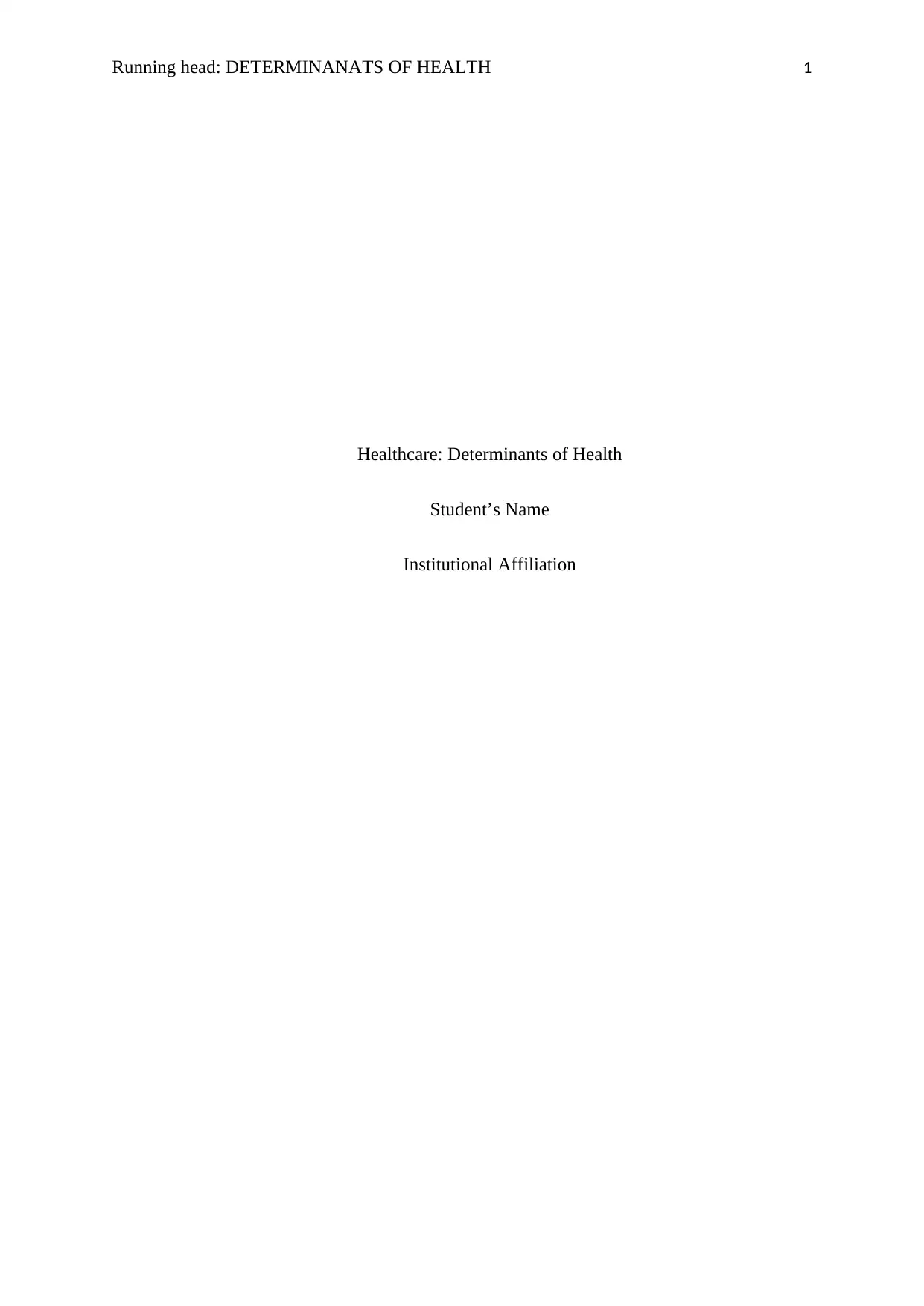
Running head: DETERMINANATS OF HEALTH 1
Healthcare: Determinants of Health
Student’s Name
Institutional Affiliation
Healthcare: Determinants of Health
Student’s Name
Institutional Affiliation
Paraphrase This Document
Need a fresh take? Get an instant paraphrase of this document with our AI Paraphraser

DETERMINANATS OF HEALTH 2
Introduction
The quality of life that human beings leave are dependent on various factors. The
factors in question arise from the major categories of economic, social, cultural, and even
political platforms. The determinants of health, therefore, refer to any of the environmental,
economic, social, or personal arrays that have a significant influence on the health of a person
or a population (Cedeño-Laurent, 2018). The determinants of health are responsible for the
health differences between or amongst a people who are found within the same or different
ecological niche. Some people may be highly vulnerable to contracting diseases more than
others. The health or living standards of people can, however, be improved as long as the
determinants are appropriately dealt with. For example, if the social determinants like poverty
may be adjusted to through reduction of educational costs and spreading employment
opportunities through the creation of such opportunities as outlined by Chen, Wan, Yang &
Zou (2015). Encouragement and improvement of agriculture and business may help cope
with the economic factors while coming up with viable environmental management and
conservation policies may reduce pollution, thus reducing the rate of morbidity due to
pollution-based diseases.
With regards to overcrowded or poorly constructed inner-city apartments, the study
seeks to identify the various health hazards related with such a structure of housing, analyze
their impacts and the level of harm that can pose on the residents or the entire community.
The Health Hazards Associated with Overcrowding or Poorly Constructed, Inner City
Apartments
The conditions of tall buildings in cities should attract a serious attention of the
construction authorities. Some of the contractors often build substandard houses which lead
to susceptibility of the buildings posing severe health risks to the residents. The buildings in
Introduction
The quality of life that human beings leave are dependent on various factors. The
factors in question arise from the major categories of economic, social, cultural, and even
political platforms. The determinants of health, therefore, refer to any of the environmental,
economic, social, or personal arrays that have a significant influence on the health of a person
or a population (Cedeño-Laurent, 2018). The determinants of health are responsible for the
health differences between or amongst a people who are found within the same or different
ecological niche. Some people may be highly vulnerable to contracting diseases more than
others. The health or living standards of people can, however, be improved as long as the
determinants are appropriately dealt with. For example, if the social determinants like poverty
may be adjusted to through reduction of educational costs and spreading employment
opportunities through the creation of such opportunities as outlined by Chen, Wan, Yang &
Zou (2015). Encouragement and improvement of agriculture and business may help cope
with the economic factors while coming up with viable environmental management and
conservation policies may reduce pollution, thus reducing the rate of morbidity due to
pollution-based diseases.
With regards to overcrowded or poorly constructed inner-city apartments, the study
seeks to identify the various health hazards related with such a structure of housing, analyze
their impacts and the level of harm that can pose on the residents or the entire community.
The Health Hazards Associated with Overcrowding or Poorly Constructed, Inner City
Apartments
The conditions of tall buildings in cities should attract a serious attention of the
construction authorities. Some of the contractors often build substandard houses which lead
to susceptibility of the buildings posing severe health risks to the residents. The buildings in
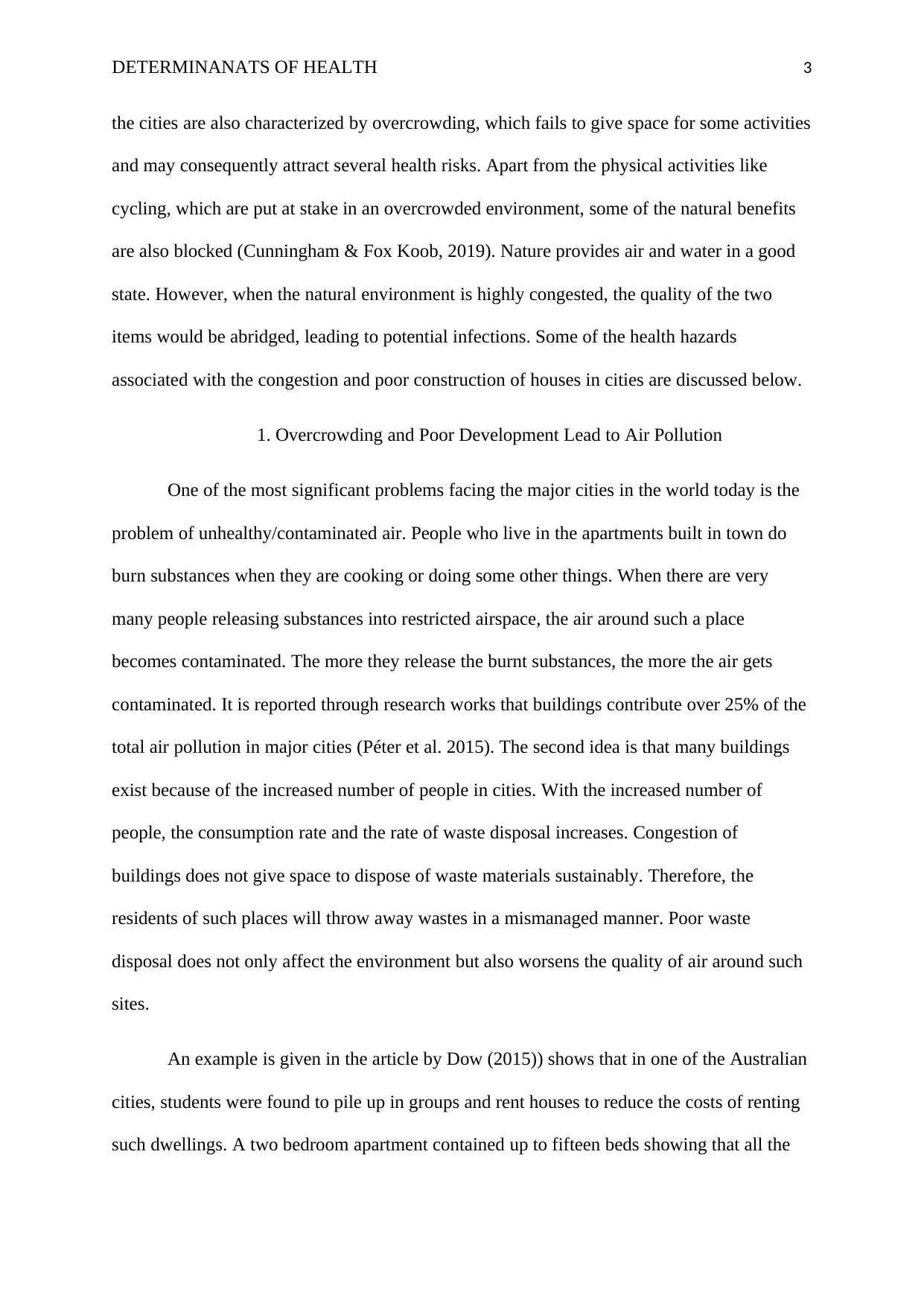
DETERMINANATS OF HEALTH 3
the cities are also characterized by overcrowding, which fails to give space for some activities
and may consequently attract several health risks. Apart from the physical activities like
cycling, which are put at stake in an overcrowded environment, some of the natural benefits
are also blocked (Cunningham & Fox Koob, 2019). Nature provides air and water in a good
state. However, when the natural environment is highly congested, the quality of the two
items would be abridged, leading to potential infections. Some of the health hazards
associated with the congestion and poor construction of houses in cities are discussed below.
1. Overcrowding and Poor Development Lead to Air Pollution
One of the most significant problems facing the major cities in the world today is the
problem of unhealthy/contaminated air. People who live in the apartments built in town do
burn substances when they are cooking or doing some other things. When there are very
many people releasing substances into restricted airspace, the air around such a place
becomes contaminated. The more they release the burnt substances, the more the air gets
contaminated. It is reported through research works that buildings contribute over 25% of the
total air pollution in major cities (Péter et al. 2015). The second idea is that many buildings
exist because of the increased number of people in cities. With the increased number of
people, the consumption rate and the rate of waste disposal increases. Congestion of
buildings does not give space to dispose of waste materials sustainably. Therefore, the
residents of such places will throw away wastes in a mismanaged manner. Poor waste
disposal does not only affect the environment but also worsens the quality of air around such
sites.
An example is given in the article by Dow (2015)) shows that in one of the Australian
cities, students were found to pile up in groups and rent houses to reduce the costs of renting
such dwellings. A two bedroom apartment contained up to fifteen beds showing that all the
the cities are also characterized by overcrowding, which fails to give space for some activities
and may consequently attract several health risks. Apart from the physical activities like
cycling, which are put at stake in an overcrowded environment, some of the natural benefits
are also blocked (Cunningham & Fox Koob, 2019). Nature provides air and water in a good
state. However, when the natural environment is highly congested, the quality of the two
items would be abridged, leading to potential infections. Some of the health hazards
associated with the congestion and poor construction of houses in cities are discussed below.
1. Overcrowding and Poor Development Lead to Air Pollution
One of the most significant problems facing the major cities in the world today is the
problem of unhealthy/contaminated air. People who live in the apartments built in town do
burn substances when they are cooking or doing some other things. When there are very
many people releasing substances into restricted airspace, the air around such a place
becomes contaminated. The more they release the burnt substances, the more the air gets
contaminated. It is reported through research works that buildings contribute over 25% of the
total air pollution in major cities (Péter et al. 2015). The second idea is that many buildings
exist because of the increased number of people in cities. With the increased number of
people, the consumption rate and the rate of waste disposal increases. Congestion of
buildings does not give space to dispose of waste materials sustainably. Therefore, the
residents of such places will throw away wastes in a mismanaged manner. Poor waste
disposal does not only affect the environment but also worsens the quality of air around such
sites.
An example is given in the article by Dow (2015)) shows that in one of the Australian
cities, students were found to pile up in groups and rent houses to reduce the costs of renting
such dwellings. A two bedroom apartment contained up to fifteen beds showing that all the
⊘ This is a preview!⊘
Do you want full access?
Subscribe today to unlock all pages.

Trusted by 1+ million students worldwide
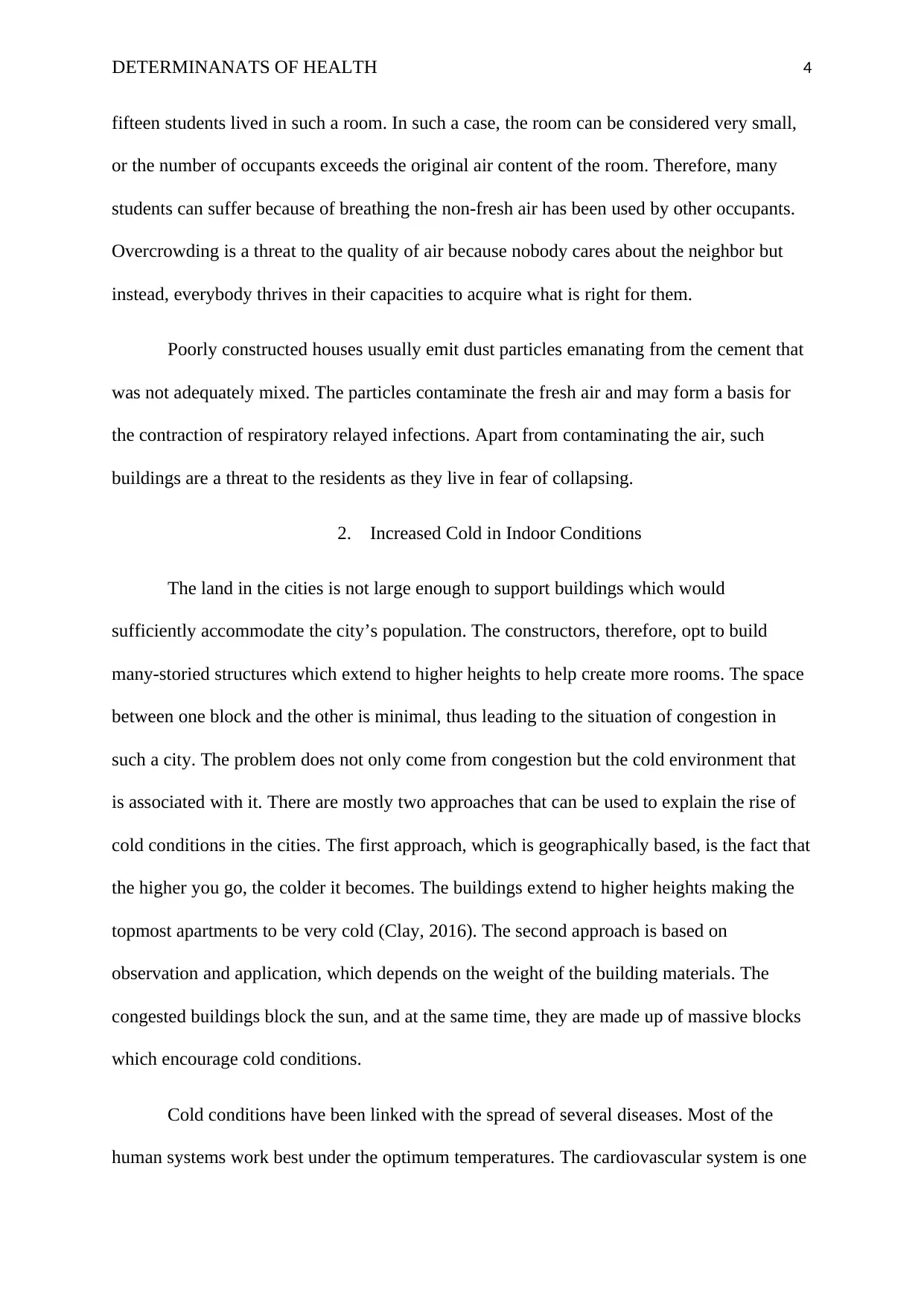
DETERMINANATS OF HEALTH 4
fifteen students lived in such a room. In such a case, the room can be considered very small,
or the number of occupants exceeds the original air content of the room. Therefore, many
students can suffer because of breathing the non-fresh air has been used by other occupants.
Overcrowding is a threat to the quality of air because nobody cares about the neighbor but
instead, everybody thrives in their capacities to acquire what is right for them.
Poorly constructed houses usually emit dust particles emanating from the cement that
was not adequately mixed. The particles contaminate the fresh air and may form a basis for
the contraction of respiratory relayed infections. Apart from contaminating the air, such
buildings are a threat to the residents as they live in fear of collapsing.
2. Increased Cold in Indoor Conditions
The land in the cities is not large enough to support buildings which would
sufficiently accommodate the city’s population. The constructors, therefore, opt to build
many-storied structures which extend to higher heights to help create more rooms. The space
between one block and the other is minimal, thus leading to the situation of congestion in
such a city. The problem does not only come from congestion but the cold environment that
is associated with it. There are mostly two approaches that can be used to explain the rise of
cold conditions in the cities. The first approach, which is geographically based, is the fact that
the higher you go, the colder it becomes. The buildings extend to higher heights making the
topmost apartments to be very cold (Clay, 2016). The second approach is based on
observation and application, which depends on the weight of the building materials. The
congested buildings block the sun, and at the same time, they are made up of massive blocks
which encourage cold conditions.
Cold conditions have been linked with the spread of several diseases. Most of the
human systems work best under the optimum temperatures. The cardiovascular system is one
fifteen students lived in such a room. In such a case, the room can be considered very small,
or the number of occupants exceeds the original air content of the room. Therefore, many
students can suffer because of breathing the non-fresh air has been used by other occupants.
Overcrowding is a threat to the quality of air because nobody cares about the neighbor but
instead, everybody thrives in their capacities to acquire what is right for them.
Poorly constructed houses usually emit dust particles emanating from the cement that
was not adequately mixed. The particles contaminate the fresh air and may form a basis for
the contraction of respiratory relayed infections. Apart from contaminating the air, such
buildings are a threat to the residents as they live in fear of collapsing.
2. Increased Cold in Indoor Conditions
The land in the cities is not large enough to support buildings which would
sufficiently accommodate the city’s population. The constructors, therefore, opt to build
many-storied structures which extend to higher heights to help create more rooms. The space
between one block and the other is minimal, thus leading to the situation of congestion in
such a city. The problem does not only come from congestion but the cold environment that
is associated with it. There are mostly two approaches that can be used to explain the rise of
cold conditions in the cities. The first approach, which is geographically based, is the fact that
the higher you go, the colder it becomes. The buildings extend to higher heights making the
topmost apartments to be very cold (Clay, 2016). The second approach is based on
observation and application, which depends on the weight of the building materials. The
congested buildings block the sun, and at the same time, they are made up of massive blocks
which encourage cold conditions.
Cold conditions have been linked with the spread of several diseases. Most of the
human systems work best under the optimum temperatures. The cardiovascular system is one
Paraphrase This Document
Need a fresh take? Get an instant paraphrase of this document with our AI Paraphraser

DETERMINANATS OF HEALTH 5
of the areas profoundly affected by cold indoor conditions. Once transformed, the victims
usually contract cardiovascular diseases, which include but not limited to heart attacks
(Adegoke, 2014). The presence of extreme temperatures profoundly influences the mortality
and morbidity of human beings. Populations which are adversely affected by the adverse
temperature ranges include the elderly and the young children whose body systems have
either lost strength as in the seniors or has not fully development body protective like in
young children. Thus, there is a need to ensure that the optimum temperature in cities is
enhanced, someth9ing which rarely exists in the congested cities.
3. Substandard Housing Give Room for Pest Infestation
Characteristics of a poorly constructed house including but not limited to poor
ventilation, leakages, and other forms of cracks. In as much as people may be thriving to keep
their homes clean to keep off pests, the presence of cracks and poor ventilation would not
give them the chance to perform such a task successfully. Various disease-causing organisms
live in a range of environments (Locatelli et al. 2017). For example, there are those in living
in water, air, and on the soil. When the ventilation of a house is inferior, there are high
chances of letting in organisms that live in the air from outside. Such organisms might be
viruses and bacteria and may be dangerous to the body of human beings when inhaled into
their systems.
Some house builders also unknowingly leave spaces in the form of leakages. Such
spaces could be used as a route to getting into the house by pests like mites, mold and several
allergens which, in most occasions, associate themselves with dirty and unhealthy
environments. The organisms allowed into the house through poor ventilation and leakages
can contaminate food and water in such rooms leading to pollution-based diseases (Luongo et
al. 2016). Other than the unwanted openings that houses have, there is the problem of dirty
of the areas profoundly affected by cold indoor conditions. Once transformed, the victims
usually contract cardiovascular diseases, which include but not limited to heart attacks
(Adegoke, 2014). The presence of extreme temperatures profoundly influences the mortality
and morbidity of human beings. Populations which are adversely affected by the adverse
temperature ranges include the elderly and the young children whose body systems have
either lost strength as in the seniors or has not fully development body protective like in
young children. Thus, there is a need to ensure that the optimum temperature in cities is
enhanced, someth9ing which rarely exists in the congested cities.
3. Substandard Housing Give Room for Pest Infestation
Characteristics of a poorly constructed house including but not limited to poor
ventilation, leakages, and other forms of cracks. In as much as people may be thriving to keep
their homes clean to keep off pests, the presence of cracks and poor ventilation would not
give them the chance to perform such a task successfully. Various disease-causing organisms
live in a range of environments (Locatelli et al. 2017). For example, there are those in living
in water, air, and on the soil. When the ventilation of a house is inferior, there are high
chances of letting in organisms that live in the air from outside. Such organisms might be
viruses and bacteria and may be dangerous to the body of human beings when inhaled into
their systems.
Some house builders also unknowingly leave spaces in the form of leakages. Such
spaces could be used as a route to getting into the house by pests like mites, mold and several
allergens which, in most occasions, associate themselves with dirty and unhealthy
environments. The organisms allowed into the house through poor ventilation and leakages
can contaminate food and water in such rooms leading to pollution-based diseases (Luongo et
al. 2016). Other than the unwanted openings that houses have, there is the problem of dirty

DETERMINANATS OF HEALTH 6
carpets, which is a characteristic of a house with many people. Dirty carpets can infect the
residents through dust particles which cause allergies or can be used as a hiding place for
dangerous organisms like bedbugs whose primary for is dust and dirt. The reasons outlined
provide indisputable evidence that poorly constructed houses and congestion of houses can
pose adverse effects on the lives of the inhabitants.
Health Impacts of the Identified Hazards
Health Impacts of Air Pollution
The quality of human life extensively depends on the quality of air which they
breathe. Even when the natural air has been contaminated, the human being will still consume
it. Thus they get exposed to several airborne diseases. Some of the disorders associated with
air pollution are discussed below.
Respiratory Disorders: - The respiratory system of human beings provides the primary
route for the entry of all sorts of contaminants to the human body. The dose levels of the
pollutants inhaled is responsible for the extent of damage caused to human health (Ladha,
2015). A short term effect can be caused to the upper tract of the respiratory system, which
irritates the trachea, thus creating a problem on the voice of the victim. Air enters the
respiratory tract in the form of Particulate Matter (PMs), chemicals, ozone, and benzene,
among others (Firdaus & Ahmad, 2013). One of the most dangerous respiratory effects of air
pollution is asthma, which is primarily caused by exposure to toxic air particles.
Cardiovascular Dysfunctions: -Various studies have identified the existence of an
unquestionable link between exposure to air pollutants or contaminated air and
cardiovascular illnesses. Clay, (2017), in his research, provides that exposure to high levels of
nitrogen (IV) Oxide (NO2) causes hypertrophy of both the left and the right ventricles. Air
carpets, which is a characteristic of a house with many people. Dirty carpets can infect the
residents through dust particles which cause allergies or can be used as a hiding place for
dangerous organisms like bedbugs whose primary for is dust and dirt. The reasons outlined
provide indisputable evidence that poorly constructed houses and congestion of houses can
pose adverse effects on the lives of the inhabitants.
Health Impacts of the Identified Hazards
Health Impacts of Air Pollution
The quality of human life extensively depends on the quality of air which they
breathe. Even when the natural air has been contaminated, the human being will still consume
it. Thus they get exposed to several airborne diseases. Some of the disorders associated with
air pollution are discussed below.
Respiratory Disorders: - The respiratory system of human beings provides the primary
route for the entry of all sorts of contaminants to the human body. The dose levels of the
pollutants inhaled is responsible for the extent of damage caused to human health (Ladha,
2015). A short term effect can be caused to the upper tract of the respiratory system, which
irritates the trachea, thus creating a problem on the voice of the victim. Air enters the
respiratory tract in the form of Particulate Matter (PMs), chemicals, ozone, and benzene,
among others (Firdaus & Ahmad, 2013). One of the most dangerous respiratory effects of air
pollution is asthma, which is primarily caused by exposure to toxic air particles.
Cardiovascular Dysfunctions: -Various studies have identified the existence of an
unquestionable link between exposure to air pollutants or contaminated air and
cardiovascular illnesses. Clay, (2017), in his research, provides that exposure to high levels of
nitrogen (IV) Oxide (NO2) causes hypertrophy of both the left and the right ventricles. Air
⊘ This is a preview!⊘
Do you want full access?
Subscribe today to unlock all pages.

Trusted by 1+ million students worldwide
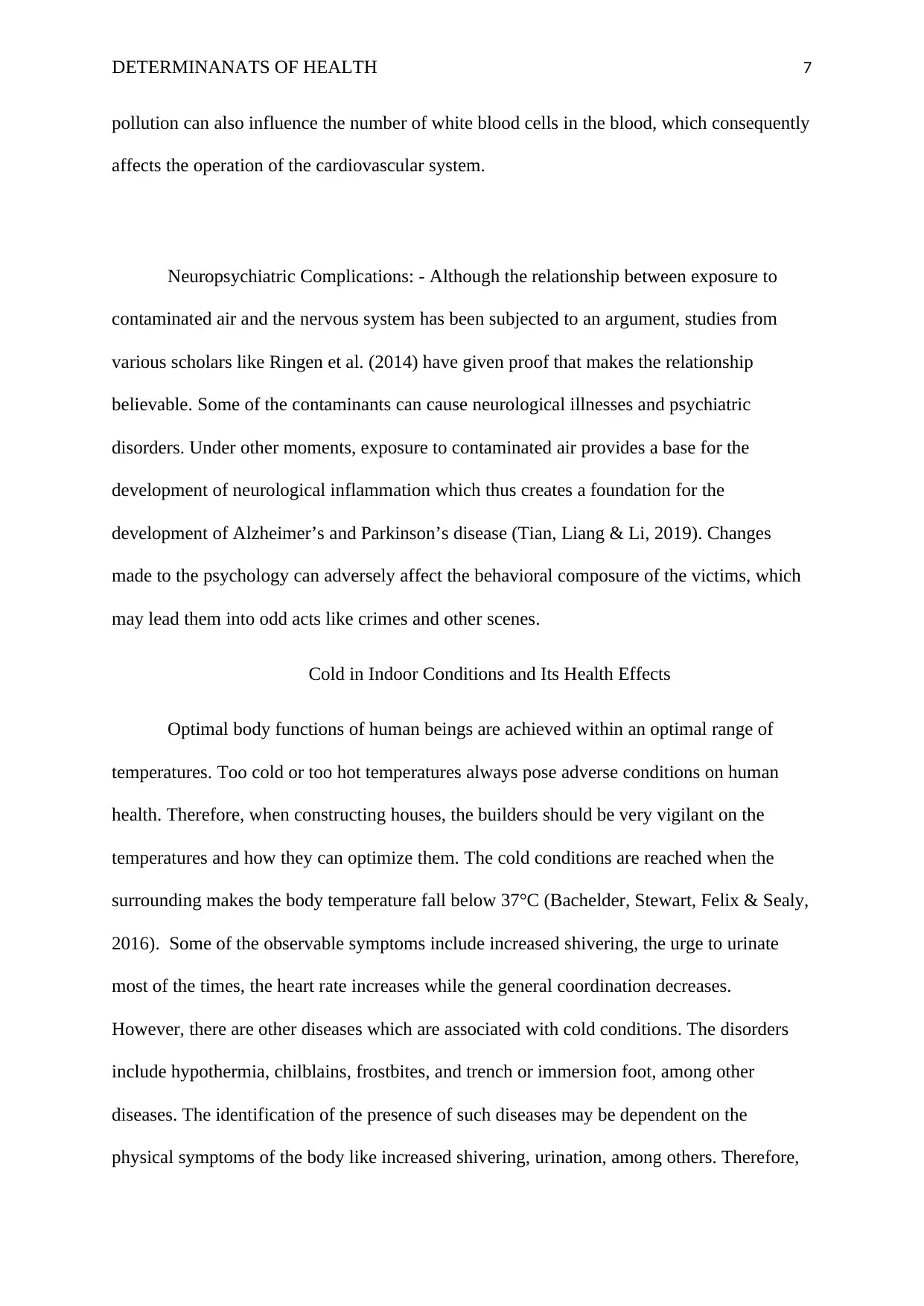
DETERMINANATS OF HEALTH 7
pollution can also influence the number of white blood cells in the blood, which consequently
affects the operation of the cardiovascular system.
Neuropsychiatric Complications: - Although the relationship between exposure to
contaminated air and the nervous system has been subjected to an argument, studies from
various scholars like Ringen et al. (2014) have given proof that makes the relationship
believable. Some of the contaminants can cause neurological illnesses and psychiatric
disorders. Under other moments, exposure to contaminated air provides a base for the
development of neurological inflammation which thus creates a foundation for the
development of Alzheimer’s and Parkinson’s disease (Tian, Liang & Li, 2019). Changes
made to the psychology can adversely affect the behavioral composure of the victims, which
may lead them into odd acts like crimes and other scenes.
Cold in Indoor Conditions and Its Health Effects
Optimal body functions of human beings are achieved within an optimal range of
temperatures. Too cold or too hot temperatures always pose adverse conditions on human
health. Therefore, when constructing houses, the builders should be very vigilant on the
temperatures and how they can optimize them. The cold conditions are reached when the
surrounding makes the body temperature fall below 37°C (Bachelder, Stewart, Felix & Sealy,
2016). Some of the observable symptoms include increased shivering, the urge to urinate
most of the times, the heart rate increases while the general coordination decreases.
However, there are other diseases which are associated with cold conditions. The disorders
include hypothermia, chilblains, frostbites, and trench or immersion foot, among other
diseases. The identification of the presence of such diseases may be dependent on the
physical symptoms of the body like increased shivering, urination, among others. Therefore,
pollution can also influence the number of white blood cells in the blood, which consequently
affects the operation of the cardiovascular system.
Neuropsychiatric Complications: - Although the relationship between exposure to
contaminated air and the nervous system has been subjected to an argument, studies from
various scholars like Ringen et al. (2014) have given proof that makes the relationship
believable. Some of the contaminants can cause neurological illnesses and psychiatric
disorders. Under other moments, exposure to contaminated air provides a base for the
development of neurological inflammation which thus creates a foundation for the
development of Alzheimer’s and Parkinson’s disease (Tian, Liang & Li, 2019). Changes
made to the psychology can adversely affect the behavioral composure of the victims, which
may lead them into odd acts like crimes and other scenes.
Cold in Indoor Conditions and Its Health Effects
Optimal body functions of human beings are achieved within an optimal range of
temperatures. Too cold or too hot temperatures always pose adverse conditions on human
health. Therefore, when constructing houses, the builders should be very vigilant on the
temperatures and how they can optimize them. The cold conditions are reached when the
surrounding makes the body temperature fall below 37°C (Bachelder, Stewart, Felix & Sealy,
2016). Some of the observable symptoms include increased shivering, the urge to urinate
most of the times, the heart rate increases while the general coordination decreases.
However, there are other diseases which are associated with cold conditions. The disorders
include hypothermia, chilblains, frostbites, and trench or immersion foot, among other
diseases. The identification of the presence of such diseases may be dependent on the
physical symptoms of the body like increased shivering, urination, among others. Therefore,
Paraphrase This Document
Need a fresh take? Get an instant paraphrase of this document with our AI Paraphraser
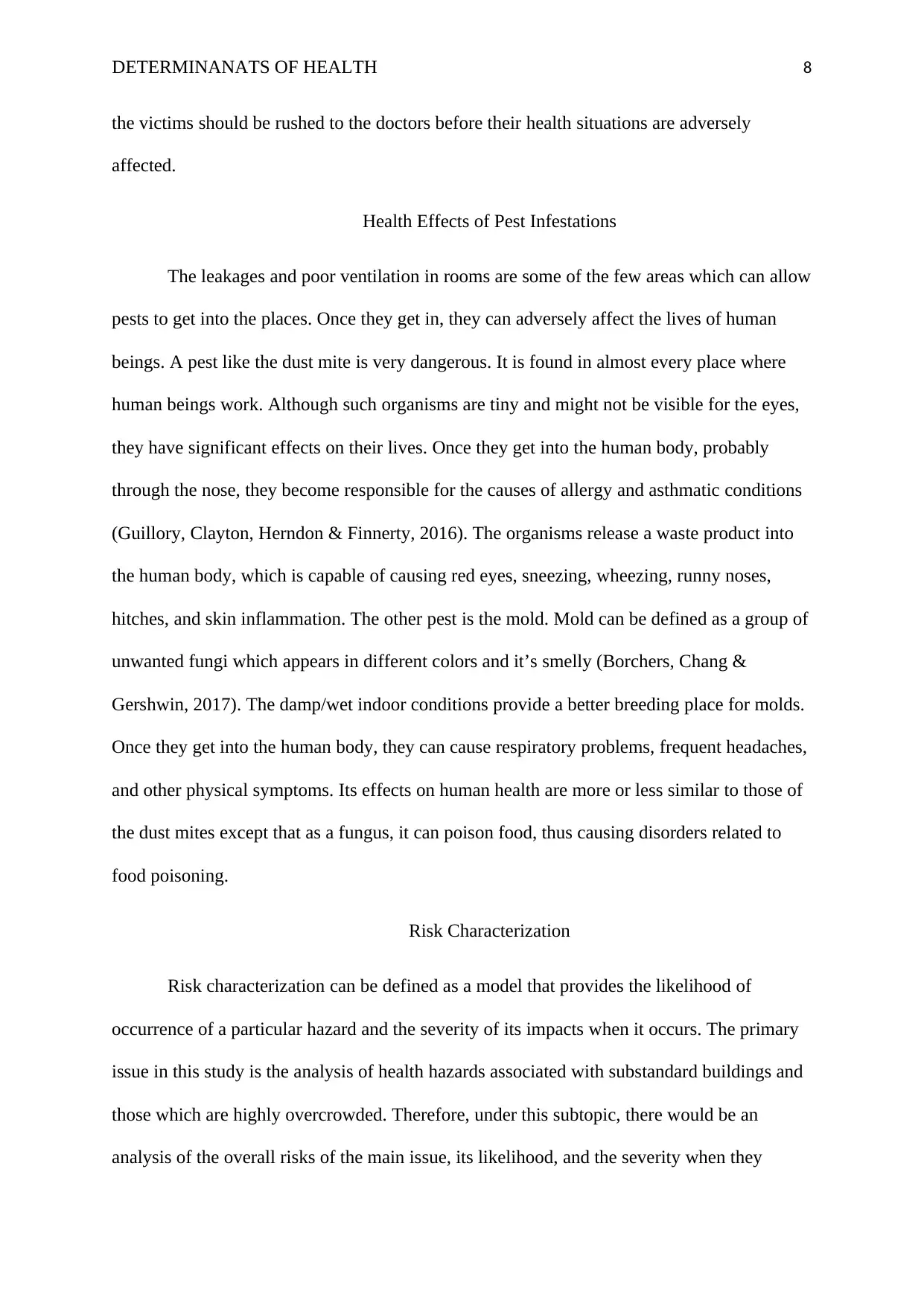
DETERMINANATS OF HEALTH 8
the victims should be rushed to the doctors before their health situations are adversely
affected.
Health Effects of Pest Infestations
The leakages and poor ventilation in rooms are some of the few areas which can allow
pests to get into the places. Once they get in, they can adversely affect the lives of human
beings. A pest like the dust mite is very dangerous. It is found in almost every place where
human beings work. Although such organisms are tiny and might not be visible for the eyes,
they have significant effects on their lives. Once they get into the human body, probably
through the nose, they become responsible for the causes of allergy and asthmatic conditions
(Guillory, Clayton, Herndon & Finnerty, 2016). The organisms release a waste product into
the human body, which is capable of causing red eyes, sneezing, wheezing, runny noses,
hitches, and skin inflammation. The other pest is the mold. Mold can be defined as a group of
unwanted fungi which appears in different colors and it’s smelly (Borchers, Chang &
Gershwin, 2017). The damp/wet indoor conditions provide a better breeding place for molds.
Once they get into the human body, they can cause respiratory problems, frequent headaches,
and other physical symptoms. Its effects on human health are more or less similar to those of
the dust mites except that as a fungus, it can poison food, thus causing disorders related to
food poisoning.
Risk Characterization
Risk characterization can be defined as a model that provides the likelihood of
occurrence of a particular hazard and the severity of its impacts when it occurs. The primary
issue in this study is the analysis of health hazards associated with substandard buildings and
those which are highly overcrowded. Therefore, under this subtopic, there would be an
analysis of the overall risks of the main issue, its likelihood, and the severity when they
the victims should be rushed to the doctors before their health situations are adversely
affected.
Health Effects of Pest Infestations
The leakages and poor ventilation in rooms are some of the few areas which can allow
pests to get into the places. Once they get in, they can adversely affect the lives of human
beings. A pest like the dust mite is very dangerous. It is found in almost every place where
human beings work. Although such organisms are tiny and might not be visible for the eyes,
they have significant effects on their lives. Once they get into the human body, probably
through the nose, they become responsible for the causes of allergy and asthmatic conditions
(Guillory, Clayton, Herndon & Finnerty, 2016). The organisms release a waste product into
the human body, which is capable of causing red eyes, sneezing, wheezing, runny noses,
hitches, and skin inflammation. The other pest is the mold. Mold can be defined as a group of
unwanted fungi which appears in different colors and it’s smelly (Borchers, Chang &
Gershwin, 2017). The damp/wet indoor conditions provide a better breeding place for molds.
Once they get into the human body, they can cause respiratory problems, frequent headaches,
and other physical symptoms. Its effects on human health are more or less similar to those of
the dust mites except that as a fungus, it can poison food, thus causing disorders related to
food poisoning.
Risk Characterization
Risk characterization can be defined as a model that provides the likelihood of
occurrence of a particular hazard and the severity of its impacts when it occurs. The primary
issue in this study is the analysis of health hazards associated with substandard buildings and
those which are highly overcrowded. Therefore, under this subtopic, there would be an
analysis of the overall risks of the main issue, its likelihood, and the severity when they
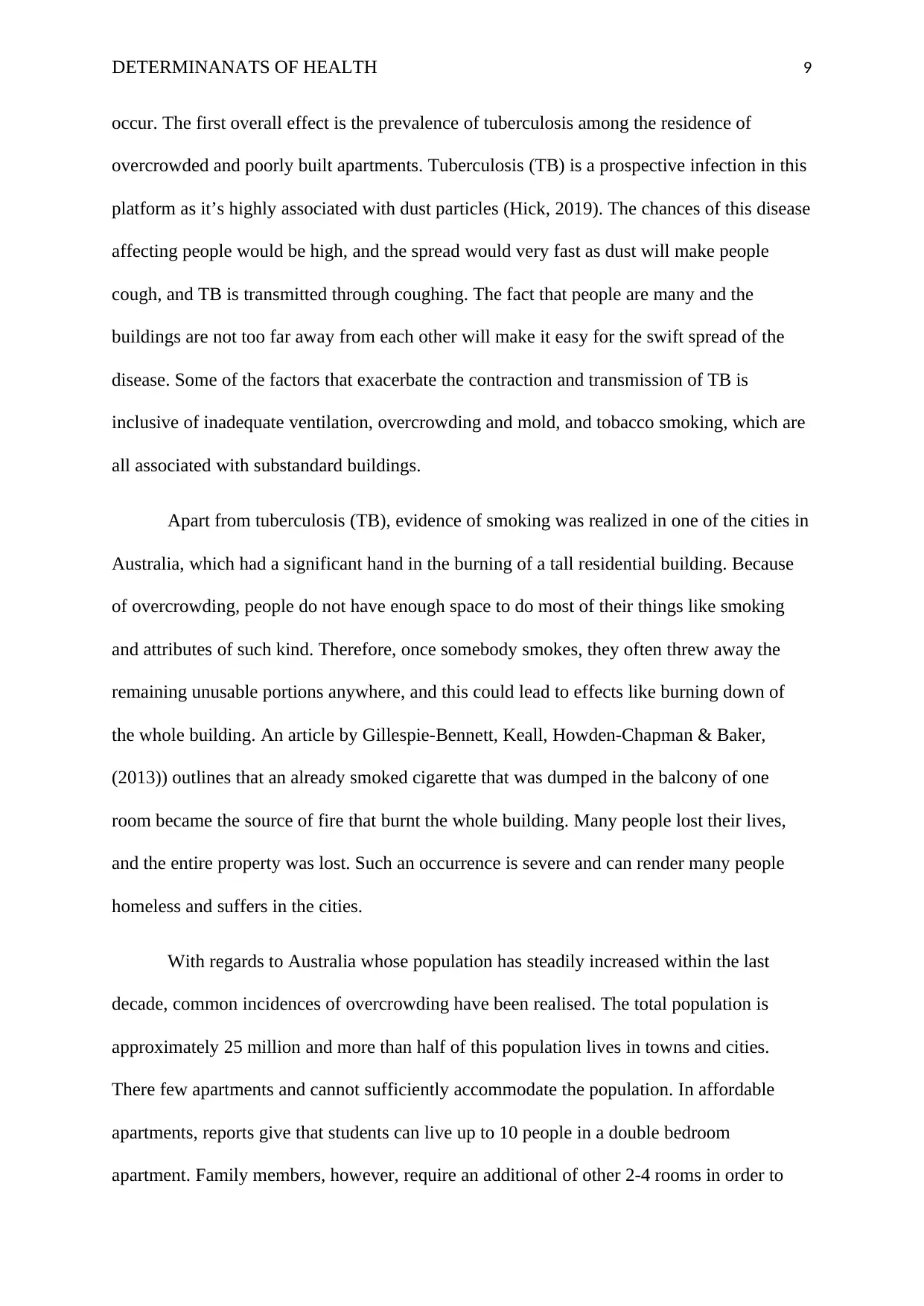
DETERMINANATS OF HEALTH 9
occur. The first overall effect is the prevalence of tuberculosis among the residence of
overcrowded and poorly built apartments. Tuberculosis (TB) is a prospective infection in this
platform as it’s highly associated with dust particles (Hick, 2019). The chances of this disease
affecting people would be high, and the spread would very fast as dust will make people
cough, and TB is transmitted through coughing. The fact that people are many and the
buildings are not too far away from each other will make it easy for the swift spread of the
disease. Some of the factors that exacerbate the contraction and transmission of TB is
inclusive of inadequate ventilation, overcrowding and mold, and tobacco smoking, which are
all associated with substandard buildings.
Apart from tuberculosis (TB), evidence of smoking was realized in one of the cities in
Australia, which had a significant hand in the burning of a tall residential building. Because
of overcrowding, people do not have enough space to do most of their things like smoking
and attributes of such kind. Therefore, once somebody smokes, they often threw away the
remaining unusable portions anywhere, and this could lead to effects like burning down of
the whole building. An article by Gillespie-Bennett, Keall, Howden-Chapman & Baker,
(2013)) outlines that an already smoked cigarette that was dumped in the balcony of one
room became the source of fire that burnt the whole building. Many people lost their lives,
and the entire property was lost. Such an occurrence is severe and can render many people
homeless and suffers in the cities.
With regards to Australia whose population has steadily increased within the last
decade, common incidences of overcrowding have been realised. The total population is
approximately 25 million and more than half of this population lives in towns and cities.
There few apartments and cannot sufficiently accommodate the population. In affordable
apartments, reports give that students can live up to 10 people in a double bedroom
apartment. Family members, however, require an additional of other 2-4 rooms in order to
occur. The first overall effect is the prevalence of tuberculosis among the residence of
overcrowded and poorly built apartments. Tuberculosis (TB) is a prospective infection in this
platform as it’s highly associated with dust particles (Hick, 2019). The chances of this disease
affecting people would be high, and the spread would very fast as dust will make people
cough, and TB is transmitted through coughing. The fact that people are many and the
buildings are not too far away from each other will make it easy for the swift spread of the
disease. Some of the factors that exacerbate the contraction and transmission of TB is
inclusive of inadequate ventilation, overcrowding and mold, and tobacco smoking, which are
all associated with substandard buildings.
Apart from tuberculosis (TB), evidence of smoking was realized in one of the cities in
Australia, which had a significant hand in the burning of a tall residential building. Because
of overcrowding, people do not have enough space to do most of their things like smoking
and attributes of such kind. Therefore, once somebody smokes, they often threw away the
remaining unusable portions anywhere, and this could lead to effects like burning down of
the whole building. An article by Gillespie-Bennett, Keall, Howden-Chapman & Baker,
(2013)) outlines that an already smoked cigarette that was dumped in the balcony of one
room became the source of fire that burnt the whole building. Many people lost their lives,
and the entire property was lost. Such an occurrence is severe and can render many people
homeless and suffers in the cities.
With regards to Australia whose population has steadily increased within the last
decade, common incidences of overcrowding have been realised. The total population is
approximately 25 million and more than half of this population lives in towns and cities.
There few apartments and cannot sufficiently accommodate the population. In affordable
apartments, reports give that students can live up to 10 people in a double bedroom
apartment. Family members, however, require an additional of other 2-4 rooms in order to
⊘ This is a preview!⊘
Do you want full access?
Subscribe today to unlock all pages.

Trusted by 1+ million students worldwide
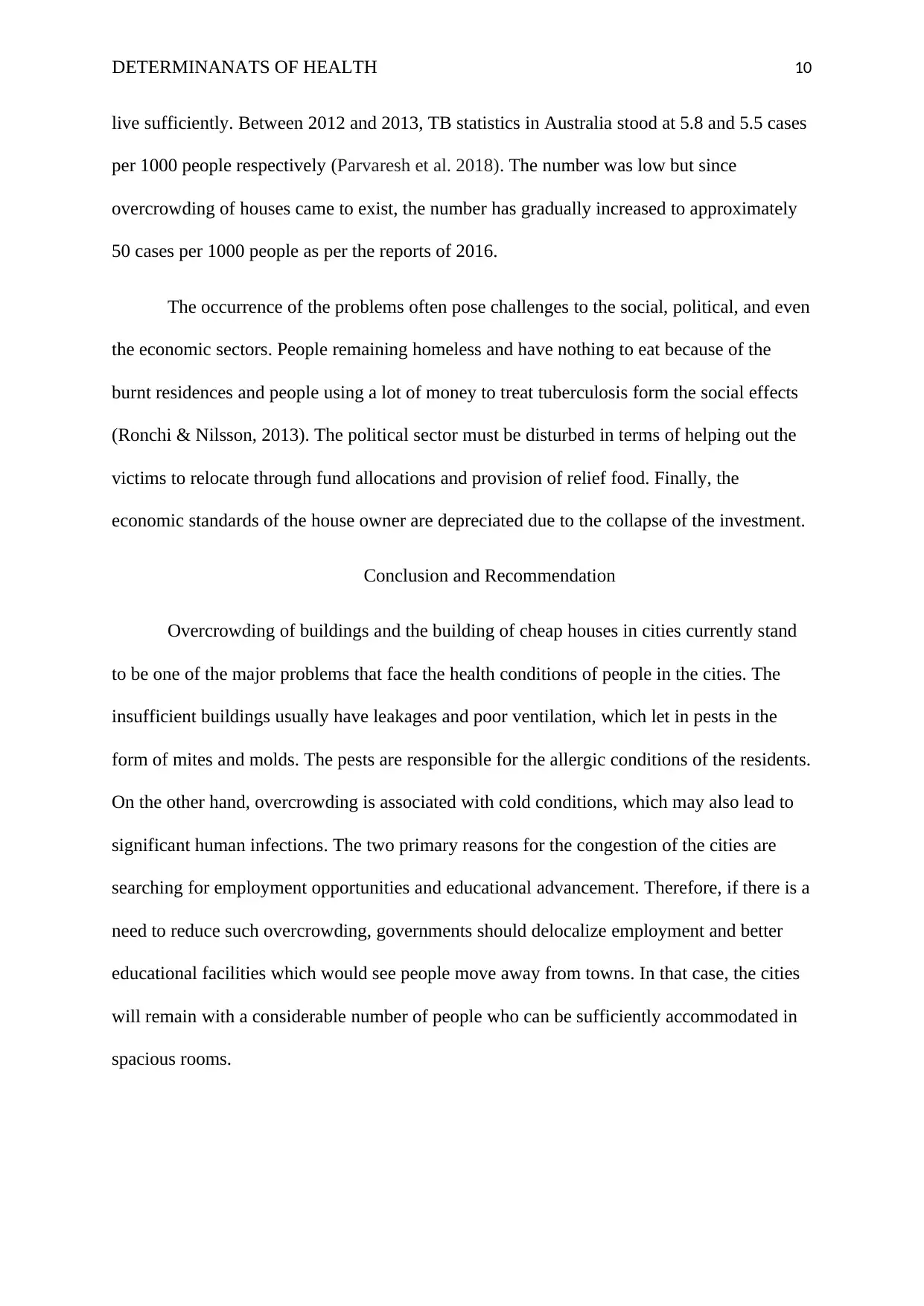
DETERMINANATS OF HEALTH 10
live sufficiently. Between 2012 and 2013, TB statistics in Australia stood at 5.8 and 5.5 cases
per 1000 people respectively (Parvaresh et al. 2018). The number was low but since
overcrowding of houses came to exist, the number has gradually increased to approximately
50 cases per 1000 people as per the reports of 2016.
The occurrence of the problems often pose challenges to the social, political, and even
the economic sectors. People remaining homeless and have nothing to eat because of the
burnt residences and people using a lot of money to treat tuberculosis form the social effects
(Ronchi & Nilsson, 2013). The political sector must be disturbed in terms of helping out the
victims to relocate through fund allocations and provision of relief food. Finally, the
economic standards of the house owner are depreciated due to the collapse of the investment.
Conclusion and Recommendation
Overcrowding of buildings and the building of cheap houses in cities currently stand
to be one of the major problems that face the health conditions of people in the cities. The
insufficient buildings usually have leakages and poor ventilation, which let in pests in the
form of mites and molds. The pests are responsible for the allergic conditions of the residents.
On the other hand, overcrowding is associated with cold conditions, which may also lead to
significant human infections. The two primary reasons for the congestion of the cities are
searching for employment opportunities and educational advancement. Therefore, if there is a
need to reduce such overcrowding, governments should delocalize employment and better
educational facilities which would see people move away from towns. In that case, the cities
will remain with a considerable number of people who can be sufficiently accommodated in
spacious rooms.
live sufficiently. Between 2012 and 2013, TB statistics in Australia stood at 5.8 and 5.5 cases
per 1000 people respectively (Parvaresh et al. 2018). The number was low but since
overcrowding of houses came to exist, the number has gradually increased to approximately
50 cases per 1000 people as per the reports of 2016.
The occurrence of the problems often pose challenges to the social, political, and even
the economic sectors. People remaining homeless and have nothing to eat because of the
burnt residences and people using a lot of money to treat tuberculosis form the social effects
(Ronchi & Nilsson, 2013). The political sector must be disturbed in terms of helping out the
victims to relocate through fund allocations and provision of relief food. Finally, the
economic standards of the house owner are depreciated due to the collapse of the investment.
Conclusion and Recommendation
Overcrowding of buildings and the building of cheap houses in cities currently stand
to be one of the major problems that face the health conditions of people in the cities. The
insufficient buildings usually have leakages and poor ventilation, which let in pests in the
form of mites and molds. The pests are responsible for the allergic conditions of the residents.
On the other hand, overcrowding is associated with cold conditions, which may also lead to
significant human infections. The two primary reasons for the congestion of the cities are
searching for employment opportunities and educational advancement. Therefore, if there is a
need to reduce such overcrowding, governments should delocalize employment and better
educational facilities which would see people move away from towns. In that case, the cities
will remain with a considerable number of people who can be sufficiently accommodated in
spacious rooms.
Paraphrase This Document
Need a fresh take? Get an instant paraphrase of this document with our AI Paraphraser
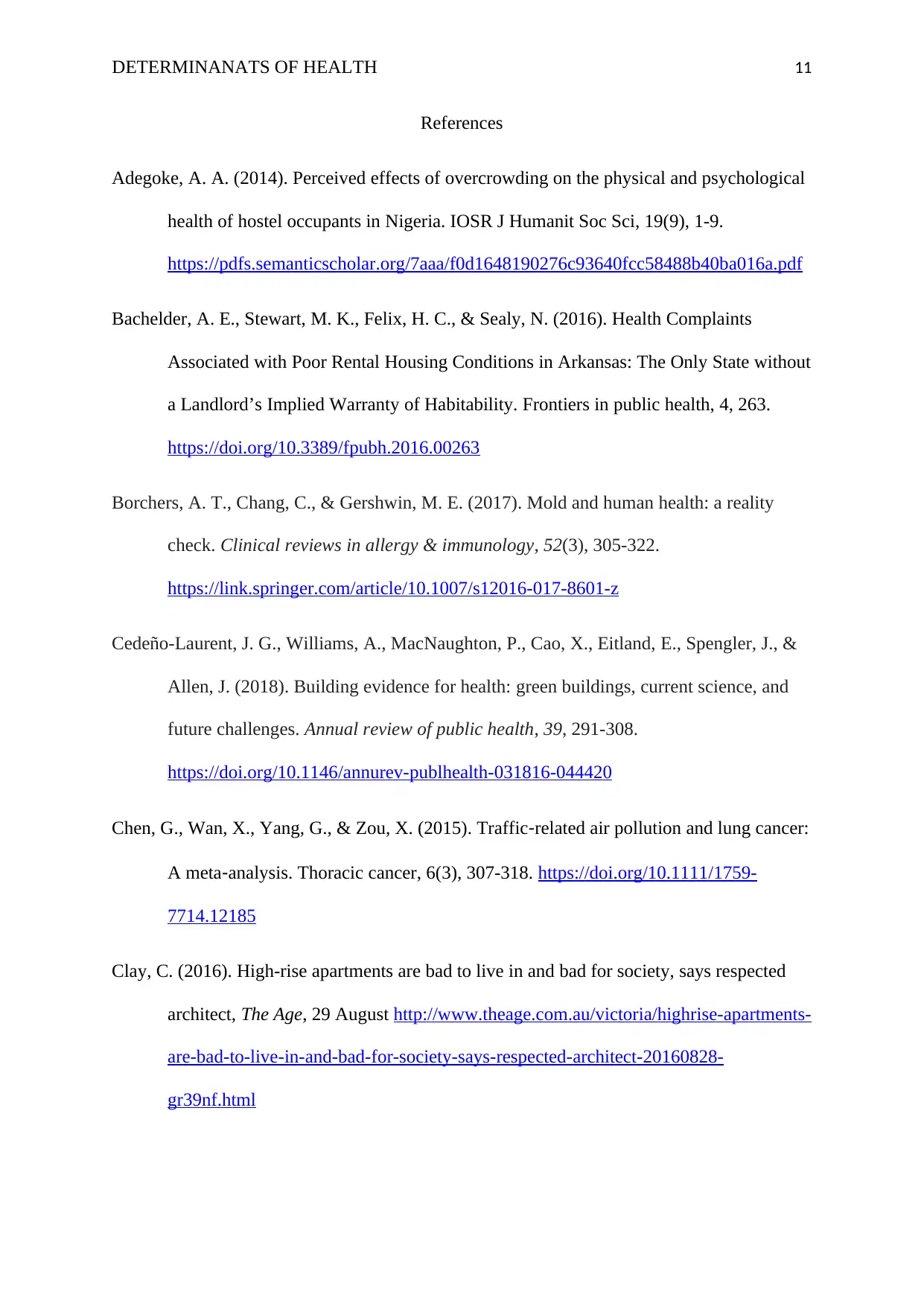
DETERMINANATS OF HEALTH 11
References
Adegoke, A. A. (2014). Perceived effects of overcrowding on the physical and psychological
health of hostel occupants in Nigeria. IOSR J Humanit Soc Sci, 19(9), 1-9.
https://pdfs.semanticscholar.org/7aaa/f0d1648190276c93640fcc58488b40ba016a.pdf
Bachelder, A. E., Stewart, M. K., Felix, H. C., & Sealy, N. (2016). Health Complaints
Associated with Poor Rental Housing Conditions in Arkansas: The Only State without
a Landlord’s Implied Warranty of Habitability. Frontiers in public health, 4, 263.
https://doi.org/10.3389/fpubh.2016.00263
Borchers, A. T., Chang, C., & Gershwin, M. E. (2017). Mold and human health: a reality
check. Clinical reviews in allergy & immunology, 52(3), 305-322.
https://link.springer.com/article/10.1007/s12016-017-8601-z
Cedeño-Laurent, J. G., Williams, A., MacNaughton, P., Cao, X., Eitland, E., Spengler, J., &
Allen, J. (2018). Building evidence for health: green buildings, current science, and
future challenges. Annual review of public health, 39, 291-308.
https://doi.org/10.1146/annurev-publhealth-031816-044420
Chen, G., Wan, X., Yang, G., & Zou, X. (2015). Traffic‐related air pollution and lung cancer:
A meta‐analysis. Thoracic cancer, 6(3), 307-318. https://doi.org/10.1111/1759-
7714.12185
Clay, C. (2016). High-rise apartments are bad to live in and bad for society, says respected
architect, The Age, 29 August http://www.theage.com.au/victoria/highrise-apartments-
are-bad-to-live-in-and-bad-for-society-says-respected-architect-20160828-
gr39nf.html
References
Adegoke, A. A. (2014). Perceived effects of overcrowding on the physical and psychological
health of hostel occupants in Nigeria. IOSR J Humanit Soc Sci, 19(9), 1-9.
https://pdfs.semanticscholar.org/7aaa/f0d1648190276c93640fcc58488b40ba016a.pdf
Bachelder, A. E., Stewart, M. K., Felix, H. C., & Sealy, N. (2016). Health Complaints
Associated with Poor Rental Housing Conditions in Arkansas: The Only State without
a Landlord’s Implied Warranty of Habitability. Frontiers in public health, 4, 263.
https://doi.org/10.3389/fpubh.2016.00263
Borchers, A. T., Chang, C., & Gershwin, M. E. (2017). Mold and human health: a reality
check. Clinical reviews in allergy & immunology, 52(3), 305-322.
https://link.springer.com/article/10.1007/s12016-017-8601-z
Cedeño-Laurent, J. G., Williams, A., MacNaughton, P., Cao, X., Eitland, E., Spengler, J., &
Allen, J. (2018). Building evidence for health: green buildings, current science, and
future challenges. Annual review of public health, 39, 291-308.
https://doi.org/10.1146/annurev-publhealth-031816-044420
Chen, G., Wan, X., Yang, G., & Zou, X. (2015). Traffic‐related air pollution and lung cancer:
A meta‐analysis. Thoracic cancer, 6(3), 307-318. https://doi.org/10.1111/1759-
7714.12185
Clay, C. (2016). High-rise apartments are bad to live in and bad for society, says respected
architect, The Age, 29 August http://www.theage.com.au/victoria/highrise-apartments-
are-bad-to-live-in-and-bad-for-society-says-respected-architect-20160828-
gr39nf.html
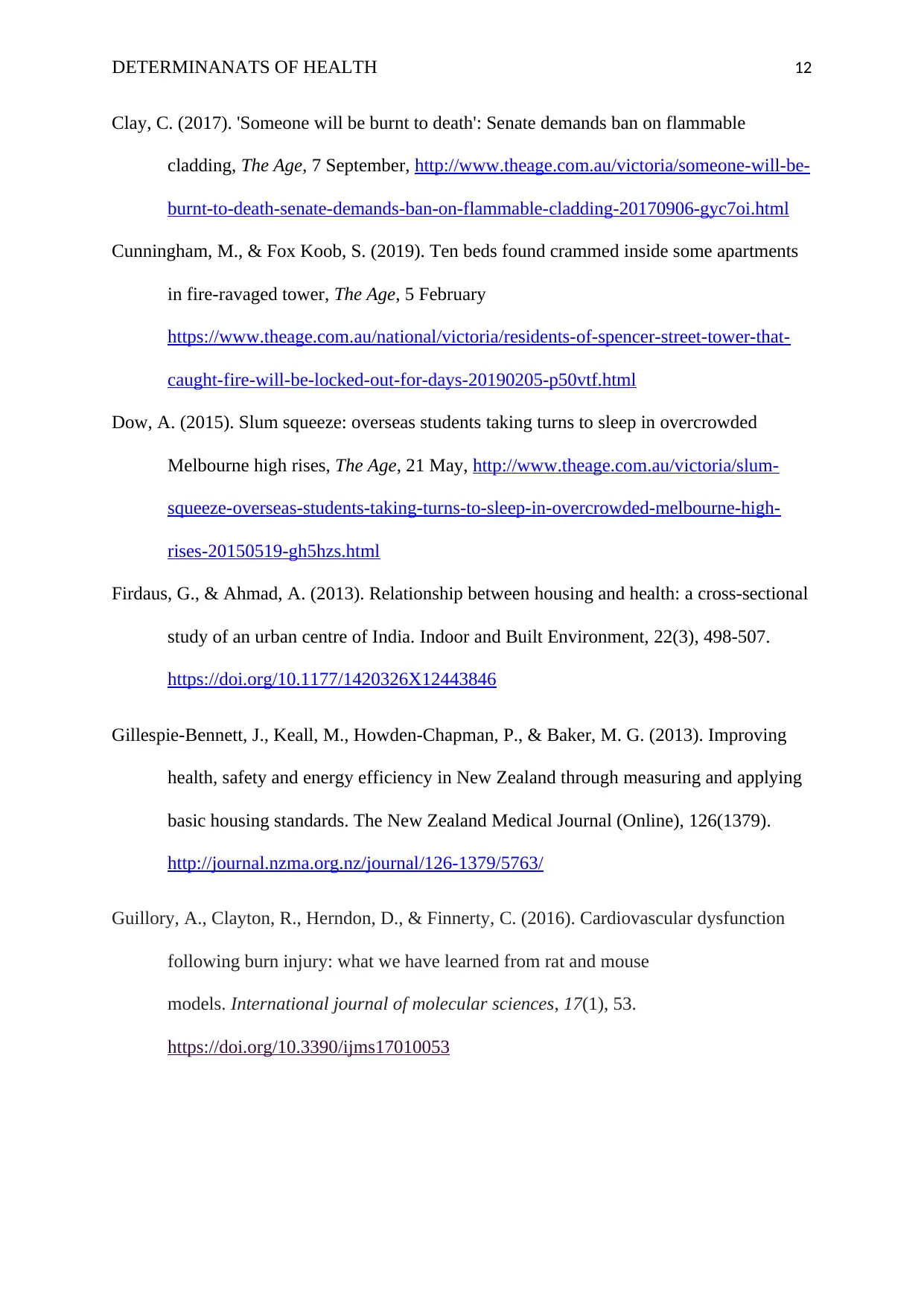
DETERMINANATS OF HEALTH 12
Clay, C. (2017). 'Someone will be burnt to death': Senate demands ban on flammable
cladding, The Age, 7 September, http://www.theage.com.au/victoria/someone-will-be-
burnt-to-death-senate-demands-ban-on-flammable-cladding-20170906-gyc7oi.html
Cunningham, M., & Fox Koob, S. (2019). Ten beds found crammed inside some apartments
in fire-ravaged tower, The Age, 5 February
https://www.theage.com.au/national/victoria/residents-of-spencer-street-tower-that-
caught-fire-will-be-locked-out-for-days-20190205-p50vtf.html
Dow, A. (2015). Slum squeeze: overseas students taking turns to sleep in overcrowded
Melbourne high rises, The Age, 21 May, http://www.theage.com.au/victoria/slum-
squeeze-overseas-students-taking-turns-to-sleep-in-overcrowded-melbourne-high-
rises-20150519-gh5hzs.html
Firdaus, G., & Ahmad, A. (2013). Relationship between housing and health: a cross-sectional
study of an urban centre of India. Indoor and Built Environment, 22(3), 498-507.
https://doi.org/10.1177/1420326X12443846
Gillespie-Bennett, J., Keall, M., Howden-Chapman, P., & Baker, M. G. (2013). Improving
health, safety and energy efficiency in New Zealand through measuring and applying
basic housing standards. The New Zealand Medical Journal (Online), 126(1379).
http://journal.nzma.org.nz/journal/126-1379/5763/
Guillory, A., Clayton, R., Herndon, D., & Finnerty, C. (2016). Cardiovascular dysfunction
following burn injury: what we have learned from rat and mouse
models. International journal of molecular sciences, 17(1), 53.
https://doi.org/10.3390/ijms17010053
Clay, C. (2017). 'Someone will be burnt to death': Senate demands ban on flammable
cladding, The Age, 7 September, http://www.theage.com.au/victoria/someone-will-be-
burnt-to-death-senate-demands-ban-on-flammable-cladding-20170906-gyc7oi.html
Cunningham, M., & Fox Koob, S. (2019). Ten beds found crammed inside some apartments
in fire-ravaged tower, The Age, 5 February
https://www.theage.com.au/national/victoria/residents-of-spencer-street-tower-that-
caught-fire-will-be-locked-out-for-days-20190205-p50vtf.html
Dow, A. (2015). Slum squeeze: overseas students taking turns to sleep in overcrowded
Melbourne high rises, The Age, 21 May, http://www.theage.com.au/victoria/slum-
squeeze-overseas-students-taking-turns-to-sleep-in-overcrowded-melbourne-high-
rises-20150519-gh5hzs.html
Firdaus, G., & Ahmad, A. (2013). Relationship between housing and health: a cross-sectional
study of an urban centre of India. Indoor and Built Environment, 22(3), 498-507.
https://doi.org/10.1177/1420326X12443846
Gillespie-Bennett, J., Keall, M., Howden-Chapman, P., & Baker, M. G. (2013). Improving
health, safety and energy efficiency in New Zealand through measuring and applying
basic housing standards. The New Zealand Medical Journal (Online), 126(1379).
http://journal.nzma.org.nz/journal/126-1379/5763/
Guillory, A., Clayton, R., Herndon, D., & Finnerty, C. (2016). Cardiovascular dysfunction
following burn injury: what we have learned from rat and mouse
models. International journal of molecular sciences, 17(1), 53.
https://doi.org/10.3390/ijms17010053
⊘ This is a preview!⊘
Do you want full access?
Subscribe today to unlock all pages.

Trusted by 1+ million students worldwide
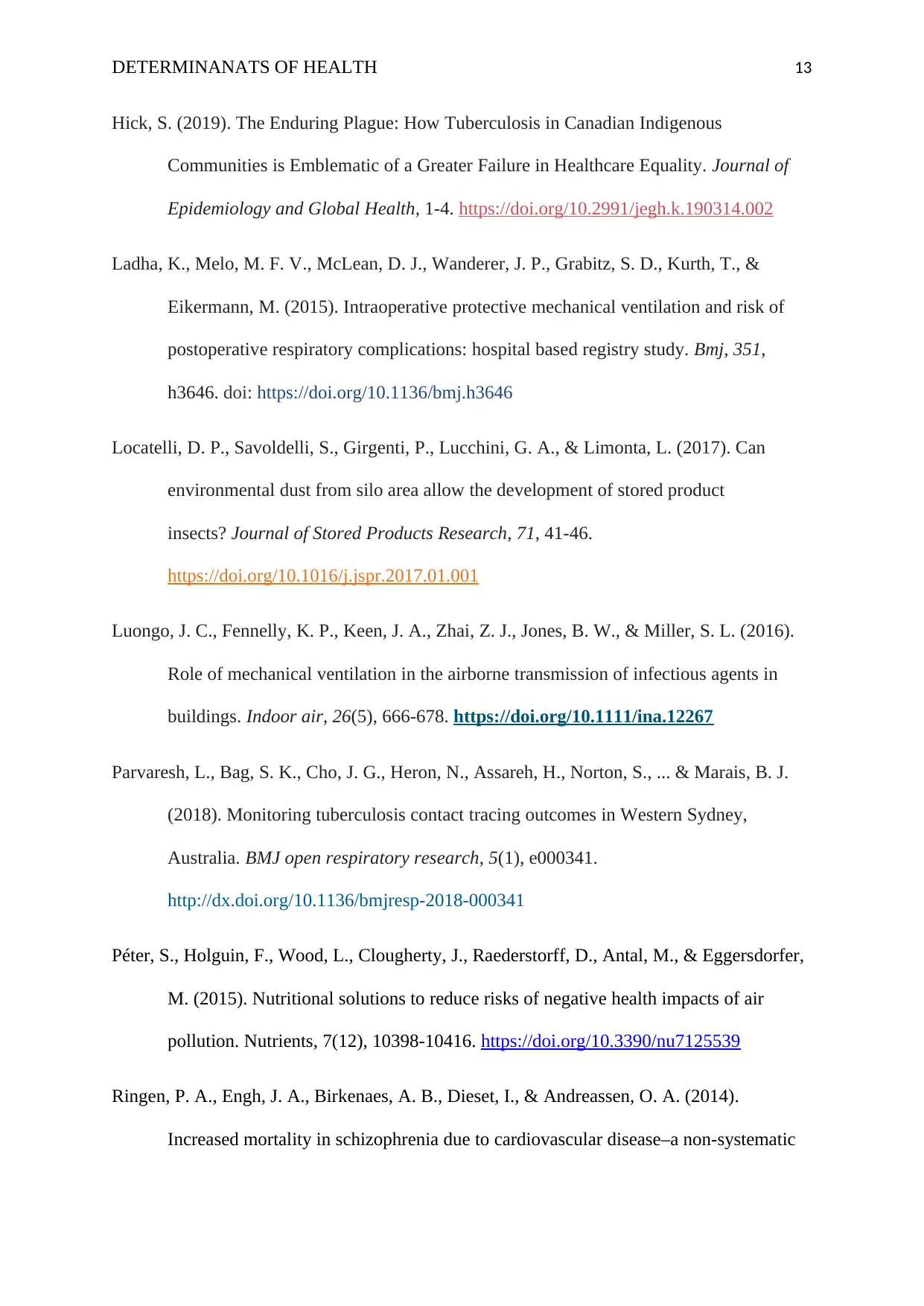
DETERMINANATS OF HEALTH 13
Hick, S. (2019). The Enduring Plague: How Tuberculosis in Canadian Indigenous
Communities is Emblematic of a Greater Failure in Healthcare Equality. Journal of
Epidemiology and Global Health, 1-4. https://doi.org/10.2991/jegh.k.190314.002
Ladha, K., Melo, M. F. V., McLean, D. J., Wanderer, J. P., Grabitz, S. D., Kurth, T., &
Eikermann, M. (2015). Intraoperative protective mechanical ventilation and risk of
postoperative respiratory complications: hospital based registry study. Bmj, 351,
h3646. doi: https://doi.org/10.1136/bmj.h3646
Locatelli, D. P., Savoldelli, S., Girgenti, P., Lucchini, G. A., & Limonta, L. (2017). Can
environmental dust from silo area allow the development of stored product
insects? Journal of Stored Products Research, 71, 41-46.
https://doi.org/10.1016/j.jspr.2017.01.001
Luongo, J. C., Fennelly, K. P., Keen, J. A., Zhai, Z. J., Jones, B. W., & Miller, S. L. (2016).
Role of mechanical ventilation in the airborne transmission of infectious agents in
buildings. Indoor air, 26(5), 666-678. https://doi.org/10.1111/ina.12267
Parvaresh, L., Bag, S. K., Cho, J. G., Heron, N., Assareh, H., Norton, S., ... & Marais, B. J.
(2018). Monitoring tuberculosis contact tracing outcomes in Western Sydney,
Australia. BMJ open respiratory research, 5(1), e000341.
http://dx.doi.org/10.1136/bmjresp-2018-000341
Péter, S., Holguin, F., Wood, L., Clougherty, J., Raederstorff, D., Antal, M., & Eggersdorfer,
M. (2015). Nutritional solutions to reduce risks of negative health impacts of air
pollution. Nutrients, 7(12), 10398-10416. https://doi.org/10.3390/nu7125539
Ringen, P. A., Engh, J. A., Birkenaes, A. B., Dieset, I., & Andreassen, O. A. (2014).
Increased mortality in schizophrenia due to cardiovascular disease–a non-systematic
Hick, S. (2019). The Enduring Plague: How Tuberculosis in Canadian Indigenous
Communities is Emblematic of a Greater Failure in Healthcare Equality. Journal of
Epidemiology and Global Health, 1-4. https://doi.org/10.2991/jegh.k.190314.002
Ladha, K., Melo, M. F. V., McLean, D. J., Wanderer, J. P., Grabitz, S. D., Kurth, T., &
Eikermann, M. (2015). Intraoperative protective mechanical ventilation and risk of
postoperative respiratory complications: hospital based registry study. Bmj, 351,
h3646. doi: https://doi.org/10.1136/bmj.h3646
Locatelli, D. P., Savoldelli, S., Girgenti, P., Lucchini, G. A., & Limonta, L. (2017). Can
environmental dust from silo area allow the development of stored product
insects? Journal of Stored Products Research, 71, 41-46.
https://doi.org/10.1016/j.jspr.2017.01.001
Luongo, J. C., Fennelly, K. P., Keen, J. A., Zhai, Z. J., Jones, B. W., & Miller, S. L. (2016).
Role of mechanical ventilation in the airborne transmission of infectious agents in
buildings. Indoor air, 26(5), 666-678. https://doi.org/10.1111/ina.12267
Parvaresh, L., Bag, S. K., Cho, J. G., Heron, N., Assareh, H., Norton, S., ... & Marais, B. J.
(2018). Monitoring tuberculosis contact tracing outcomes in Western Sydney,
Australia. BMJ open respiratory research, 5(1), e000341.
http://dx.doi.org/10.1136/bmjresp-2018-000341
Péter, S., Holguin, F., Wood, L., Clougherty, J., Raederstorff, D., Antal, M., & Eggersdorfer,
M. (2015). Nutritional solutions to reduce risks of negative health impacts of air
pollution. Nutrients, 7(12), 10398-10416. https://doi.org/10.3390/nu7125539
Ringen, P. A., Engh, J. A., Birkenaes, A. B., Dieset, I., & Andreassen, O. A. (2014).
Increased mortality in schizophrenia due to cardiovascular disease–a non-systematic
Paraphrase This Document
Need a fresh take? Get an instant paraphrase of this document with our AI Paraphraser
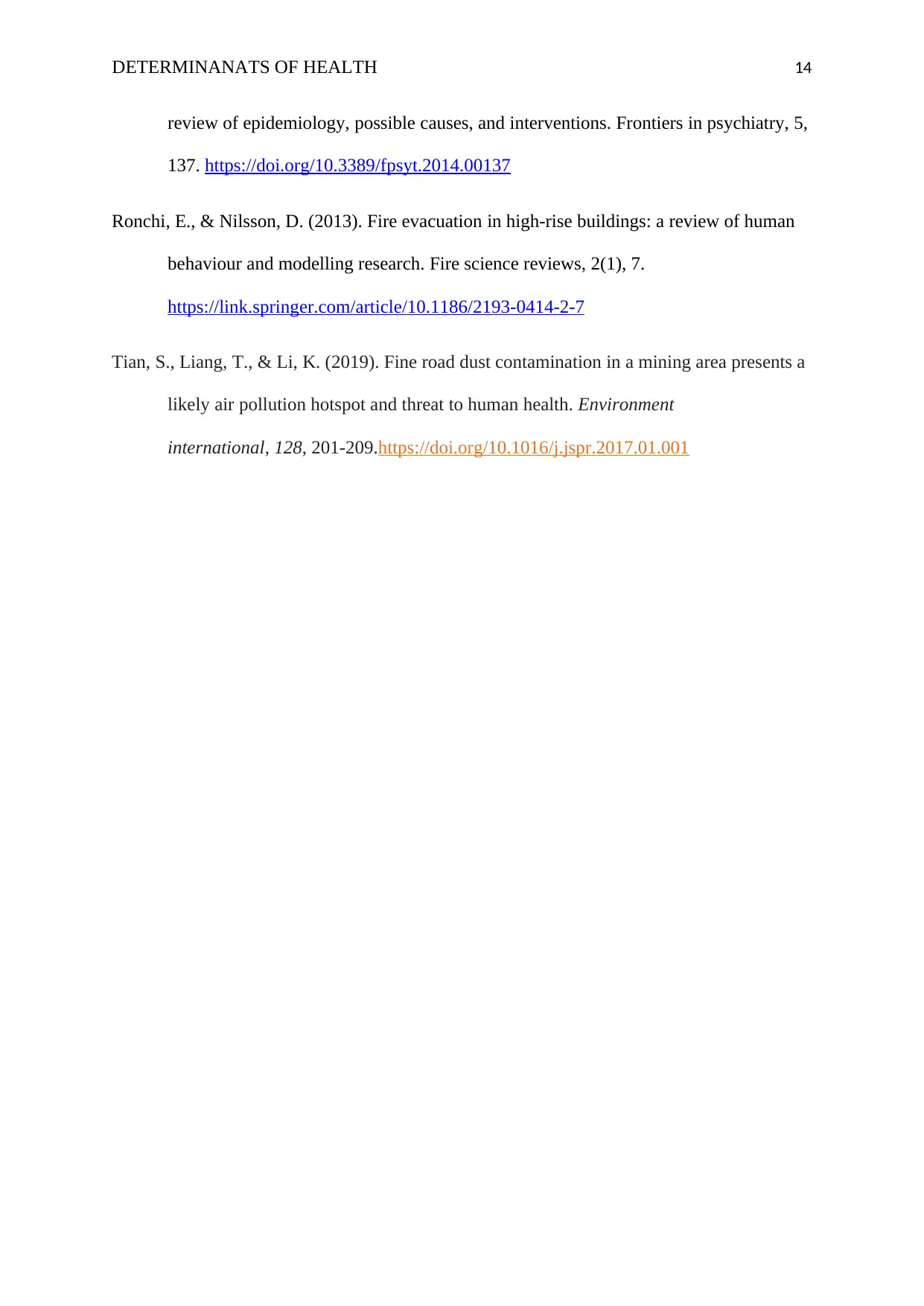
DETERMINANATS OF HEALTH 14
review of epidemiology, possible causes, and interventions. Frontiers in psychiatry, 5,
137. https://doi.org/10.3389/fpsyt.2014.00137
Ronchi, E., & Nilsson, D. (2013). Fire evacuation in high-rise buildings: a review of human
behaviour and modelling research. Fire science reviews, 2(1), 7.
https://link.springer.com/article/10.1186/2193-0414-2-7
Tian, S., Liang, T., & Li, K. (2019). Fine road dust contamination in a mining area presents a
likely air pollution hotspot and threat to human health. Environment
international, 128, 201-209.https://doi.org/10.1016/j.jspr.2017.01.001
review of epidemiology, possible causes, and interventions. Frontiers in psychiatry, 5,
137. https://doi.org/10.3389/fpsyt.2014.00137
Ronchi, E., & Nilsson, D. (2013). Fire evacuation in high-rise buildings: a review of human
behaviour and modelling research. Fire science reviews, 2(1), 7.
https://link.springer.com/article/10.1186/2193-0414-2-7
Tian, S., Liang, T., & Li, K. (2019). Fine road dust contamination in a mining area presents a
likely air pollution hotspot and threat to human health. Environment
international, 128, 201-209.https://doi.org/10.1016/j.jspr.2017.01.001
1 out of 14
Related Documents
Your All-in-One AI-Powered Toolkit for Academic Success.
+13062052269
info@desklib.com
Available 24*7 on WhatsApp / Email
![[object Object]](/_next/static/media/star-bottom.7253800d.svg)
Unlock your academic potential
© 2024 | Zucol Services PVT LTD | All rights reserved.





